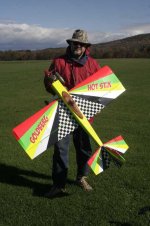ScubaFinder
Bronze Member
- Jul 11, 2006
- 2,220
- 530
- Detector(s) used
- AquaPulse AQ1B - AquaPulse DX-200 Magnetometer
- Primary Interest:
- Shipwrecks
I've seen a few posts lately regarding using RC airplanes to survey areas, since I've been doing this for years, I thought I'd offer some advice and expertise on the matter for anyone interested. First let me say that there are a lot of junk products out there, and second, you must first learn to FLY one before you can effectively strap a camera on it and put it use.
With thise things in mind, my suggestion would be to get an electric powered sailplane, very easy to fly, and cheap (respectively) to set up. There are many makers of high density foam aircraft that can really take a beating. My personal recommendation is the Easy Star from Hobby Lobby, I just taught a friend how to fly with this airplane and he had no trouble at all...really easy to fly, VERY durable, and a perfect platform for the camera system we are talking about. - $189.00
http://www.hobby-lobby.com/easystar-rtf.htm
Next is the camera system...don't be fooled by the range estimates that most give these things, with an economy model, you'll get just under one mile, and the video will start to break up once in a while starting at about 1/2 mile. I use this system in a very simple method, I research and find an area that has potential, then I get a plat map from the county with Land Owners names, then I go fly over the plats and see which ones I want to contact based on what I see from the air. The camera I'm using right now (best for the money) is the RaidenTech Mini Wireless SpyCam at $74.95
http://www.raidentech.com/24ghzmiwicoc.html
I set up the ground station to be battery operated, and record the flights on my camcorder for later review on the big screen. This also allows me to watch the flight in the LCD of the camcorder and go down for a closer look on targets of interest. So far I've only made a few flights to scope metal detecting sites, I'm kinda new to this. I'm an old hand at RC flying and onboard cameras though. If you think this could help you, this is probably the cheapest, easiest to fly setup for getting it done. I'll get some pics of my setup soon so you can see how I have everything rigged up for the ground station, basically a 10 cell NiCad battery pack providing the 12 volts for the reciever station and a Sony HandyCam.
In the mean time, here is some video I shot a few years back over a model airplane fun fly with a slightly older setup. This had the cam on the wing pointed outward, I now fly with them pointed down for easier orientation. Bear in mind that this was on a very lightweight aerobatic model on a very windy day with an older camera setup, and it's been compressed for veiwing on the web. The video nowadays (which I will post AFTER I have hunded the great site I found with it) is much more stable and clear. The video of the site has too many easily "findable" landmarks in it.
I'll answer any questions any of you may have...just thought I'd put a little experience into the matter for whoever is interested. Here is the video.
http://www.rcgroups.com/articles/ezonemag/2003/sep/neat/neat.wmv
Jason
With thise things in mind, my suggestion would be to get an electric powered sailplane, very easy to fly, and cheap (respectively) to set up. There are many makers of high density foam aircraft that can really take a beating. My personal recommendation is the Easy Star from Hobby Lobby, I just taught a friend how to fly with this airplane and he had no trouble at all...really easy to fly, VERY durable, and a perfect platform for the camera system we are talking about. - $189.00
http://www.hobby-lobby.com/easystar-rtf.htm
Next is the camera system...don't be fooled by the range estimates that most give these things, with an economy model, you'll get just under one mile, and the video will start to break up once in a while starting at about 1/2 mile. I use this system in a very simple method, I research and find an area that has potential, then I get a plat map from the county with Land Owners names, then I go fly over the plats and see which ones I want to contact based on what I see from the air. The camera I'm using right now (best for the money) is the RaidenTech Mini Wireless SpyCam at $74.95
http://www.raidentech.com/24ghzmiwicoc.html
I set up the ground station to be battery operated, and record the flights on my camcorder for later review on the big screen. This also allows me to watch the flight in the LCD of the camcorder and go down for a closer look on targets of interest. So far I've only made a few flights to scope metal detecting sites, I'm kinda new to this. I'm an old hand at RC flying and onboard cameras though. If you think this could help you, this is probably the cheapest, easiest to fly setup for getting it done. I'll get some pics of my setup soon so you can see how I have everything rigged up for the ground station, basically a 10 cell NiCad battery pack providing the 12 volts for the reciever station and a Sony HandyCam.
In the mean time, here is some video I shot a few years back over a model airplane fun fly with a slightly older setup. This had the cam on the wing pointed outward, I now fly with them pointed down for easier orientation. Bear in mind that this was on a very lightweight aerobatic model on a very windy day with an older camera setup, and it's been compressed for veiwing on the web. The video nowadays (which I will post AFTER I have hunded the great site I found with it) is much more stable and clear. The video of the site has too many easily "findable" landmarks in it.

I'll answer any questions any of you may have...just thought I'd put a little experience into the matter for whoever is interested. Here is the video.
http://www.rcgroups.com/articles/ezonemag/2003/sep/neat/neat.wmv
Jason




 I'd always wanted to do aerial recon, saw an opportunity, and took it. I think that's what TNET is all about...if it works for you, tell people about it. If it helps one person, one time, I'm happy.
I'd always wanted to do aerial recon, saw an opportunity, and took it. I think that's what TNET is all about...if it works for you, tell people about it. If it helps one person, one time, I'm happy.
